Quick search
CTRL+K
Quick search
CTRL+K

Aarhus is a cozy city with lovely pedestrian streets such as the stretch between the city’s main railroad station and Aarhus Cathedral. The attractions in the same city center area are interesting to see, and there is also access to the beautiful and relatively new city scape along the river Aarhus Å.
Aarhus’s churches are also some interesting places to visit. The city’s cathedral is one of the country’s largest churches, and the neighboring Our Lady exudes medieval character. The contrast from here to the new buildings in the port area of Aarhus is great and perspective-rich as each a contemporary architectural gem.
Aarhus also has a few must visit museums, where some of the well-known ones are the ARoS art museum and the fantastic market town environment from a bygone era in The Old City. The Old City is a unique market town museum with a collection of older houses that have been moved to here, and in addition you can visit places that stand as time capsules, for example, from several periods in the 1900s.
In the vicinity of Aarhus, the sights are also numerous, and there is a great variety of possibilities. Beautiful scenery, old mansions and thrilling amusement parks for children of all ages are just some of the things you can choose to see and do. For the maritime interested, both S/S Hjejlen and the frigate Jutland are internationally unique activities.
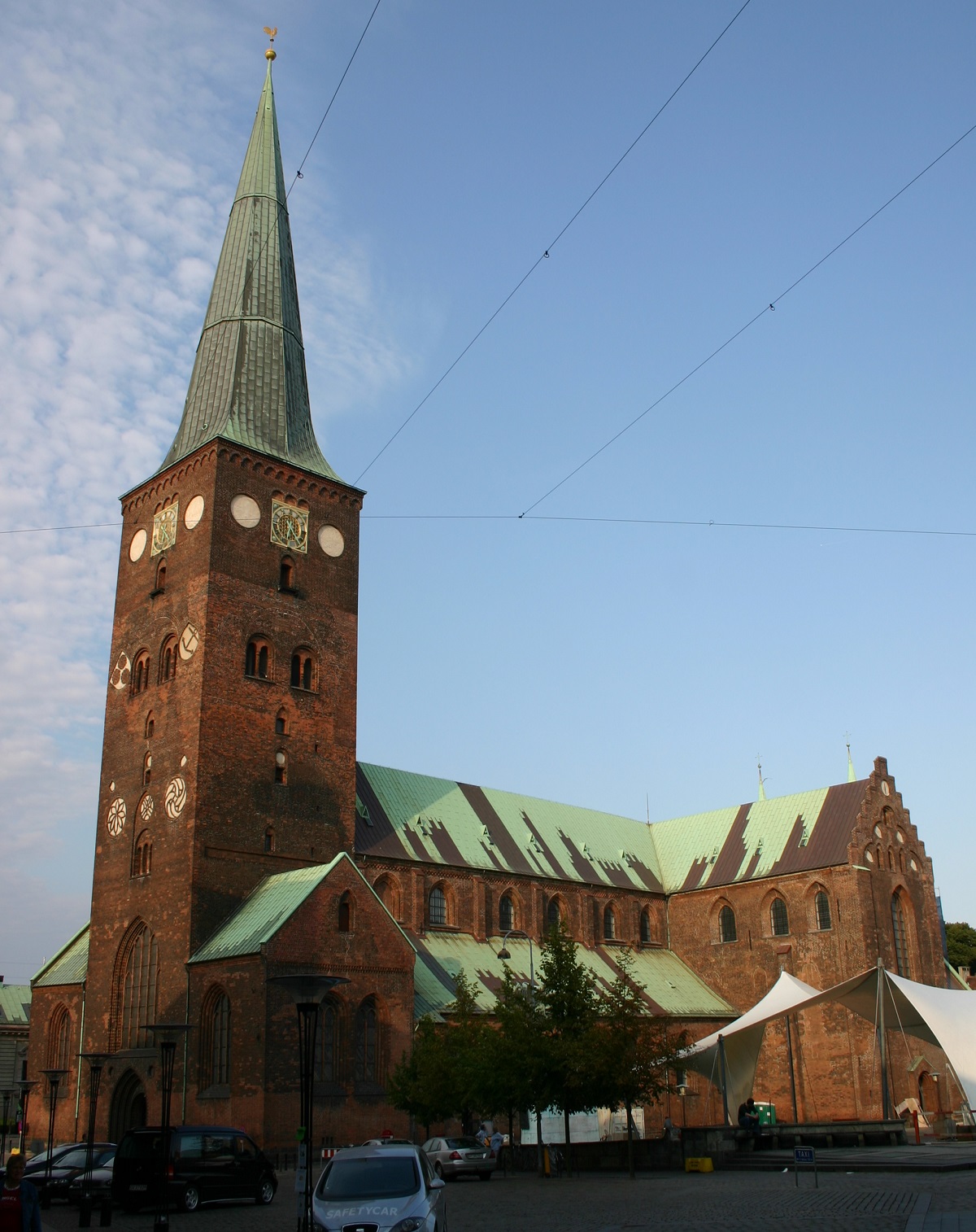
Aarhus Cathedral is the most important church in Aarhus Diocese. It is dedicated to St. Clemens, who is the saint of seafarers, which suited the then location quite close to the water compared to today. Church construction was started around the year 1200 in the Romanesque style by Bishop Peder Vognsen. The remains of the Romanesque church, which burned down in 1330, can still be seen today in the now Gothic cathedral. The cathedral was expanded until the end of the 15th century.
The first known bishop in Aarhus was Reginbrand, who was mentioned in the year 948. Already at this time there has therefore been a precursor to the current cathedral, and it is believed to have been located at the place where Our Lady’s Church is located today. The location of today’s cathedral is due to the burial of the saint Niels the Holy, who was a prince. He was buried right here, and a small wooden chapel was built at the grave from the year 1180, which after a few years was replaced by the stone church, which became the city’s new cathedral.
Aarhus Cathedral is a mighty building, and the large church is Denmark’s longest church at 93 metres. The tower with its slender spire reaches a height of 96 metres, and there is access to visit the tower.
The church’s attractions are not least the beautiful altarpiece from 1479 by Bernt Notke from Lübeck and Denmark’s largest total area of frescoes. During the Reformation, many of the earlier paintings were lost, but here you can see, among other things, one of a whopping 220 square meters. The frescoes date from the years 1470-1520, except for one that shows leprosy, which dates from the 14th-century Romanesque church.
The cathedral’s baptismal font was cast by Peter Hansen in Flensburg in 1481. It depicts an inverted church bell being carried by the four evangelists. The pulpit is from 1588 and made in fine Renaissance style by the Dutch Mikkel van Groningen.
Aarhus City Hall is the seat of both the city council in Aarhus and the city’s administration. At the same time, the town hall is one of the East Jutland city’s best-known buildings. The listed town hall was built in the years 1938-1941 by Arne Jacobsen and Erik Møller, and since then the building with the 60 meter high town hall tower has become Aarhus’ landmark.
In 1937, the town’s then town hall had become too small, and it was decided to hold an architectural competition. In just 12 days, the judging committee unanimously chose Arne Jacobsen and Erik Møller’s proposal. However, they had to revise the proposal to make the town hall more monumental, and the result came a few months later with a newly designed tower and marble on the facades.
The city hall and the tower are covered with Norwegian marble from Porsgrunn, and inside moss oak and Italian mosaics are used in the floor of the town hall and handwoven Askovhus carpet in the town council hall. In the town hall hall, the west wall is made of glass and the others are in fluted beech. Cuba mahogany is used in the city council hall. These are just a few examples of the many interesting details in the impressive town hall building.
Arne Jacobsen and Erik Møller have drawn and designed Aarhus Town Hall from the broad lines to every small detail. An example is Arne Jacobsen’s clocks, which adorn the interior of the building and also the town hall tower. Lamps and even details such as the font used in the town hall are also designed for the purpose. The building’s furniture was co-designed by Arne Jacobsen and Erik Møller in collaboration with furniture architect Hans J. Wegner.
The city hall is the city’s third town hall building. The first was built in the 15th century and was located around the current cathedral’s tower. The second town hall was built in 1856-1857. It still stands and since 1984 has been set up as the Women’s Museum in Denmark.
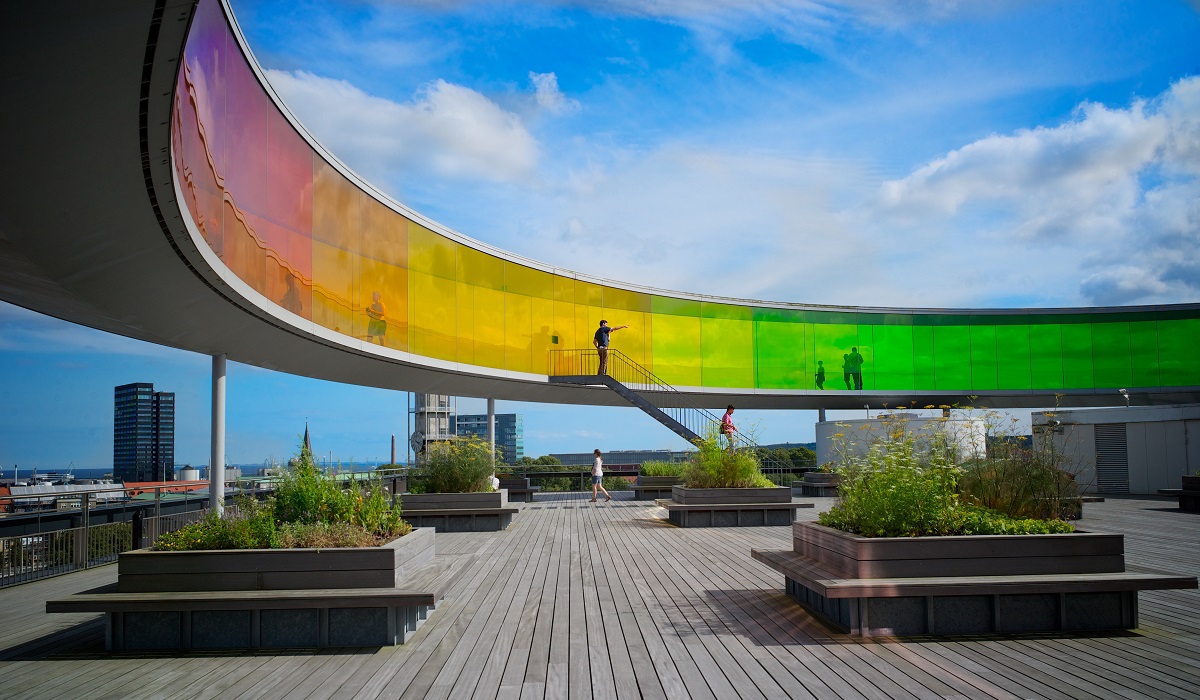
ARoS is Aarhus’ largest art museum and, with its large exhibition building, also one of the most extensive in Scandinavia. ARoS opened in 2004 in a modern museum building designed by the architectural firm Schmidt, Hammer & Lassen. The museum is cubist in stone and glass on ten floors with a floor area of just over 50×50 metres.
The art museum contains a fine collection of international art from the 18th century to the present day. They also aim to constantly have exciting exhibitions on international contemporary art; among other things within installations. ARoS also contains a number of activity exhibitions for children and young people.
The name ARoS comes from the old name for the city of Aarhus, and the art museum has also become a cultural beacon in the East Jutland city. Building-wise, ARoS has also become a landmark with the Danish-Icelandic Olafur Eliasson’s large circle on the museum’s roof; it bears the name Your Rainbow Panorama.
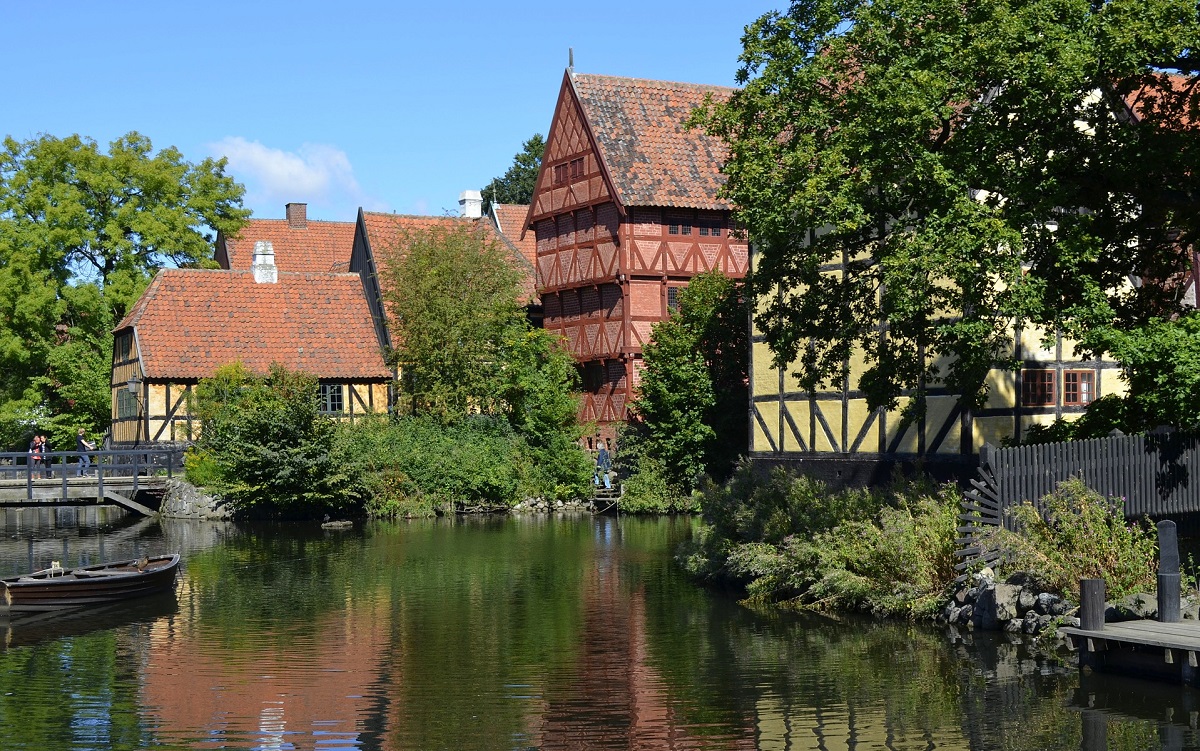
Den Gamle By is a unique open-air museum focused on Danish market town environments. It belongs among Denmark’s absolute finest museums and a must on a trip to Aarhus.
The museum was started in 1914 based on the old mayor’s farm from Aarhus, which was erected in 1909 in connection with a country exhibition, and three other buildings that were moved to the area to be preserved. Until 1945, more than 50 old market town houses were saved from demolition and moved to the Old Town, thereby preserving a unique environment from old-time Denmark.
In Europe, the museum has provided inspiration for the preservation of original urban environments from market towns, which would otherwise have been replaced in large renovation projects in the name of development. Alongside the houses themselves, Den Gamle By has also built up large collections of interiors, toys, costumes, coins and other effects that can depict the daily life of the time.
Today, the city museum contains 75 buildings from 20 different Danish cities. They represent the period from the Middle Ages to the 20th century. The buildings are built like a market town with shops, workshops, homes, a school, a pharmacy etc., and thereby you can experience both the houses themselves and scenes, environments and pockets of time in a wide range of areas. From more recent times, there are environments from 1927 and 1974 respectively.
In Den Gamle By you can also visit the city museum Museum Aarhus, which depicts the history of Aarhus from the Viking Age to the present day. The greatest emphasis has been placed on the past centuries, when Aarhus developed strongly as an industrial and university city. Photographs, stories and effects are a part of the fine conveying museum.
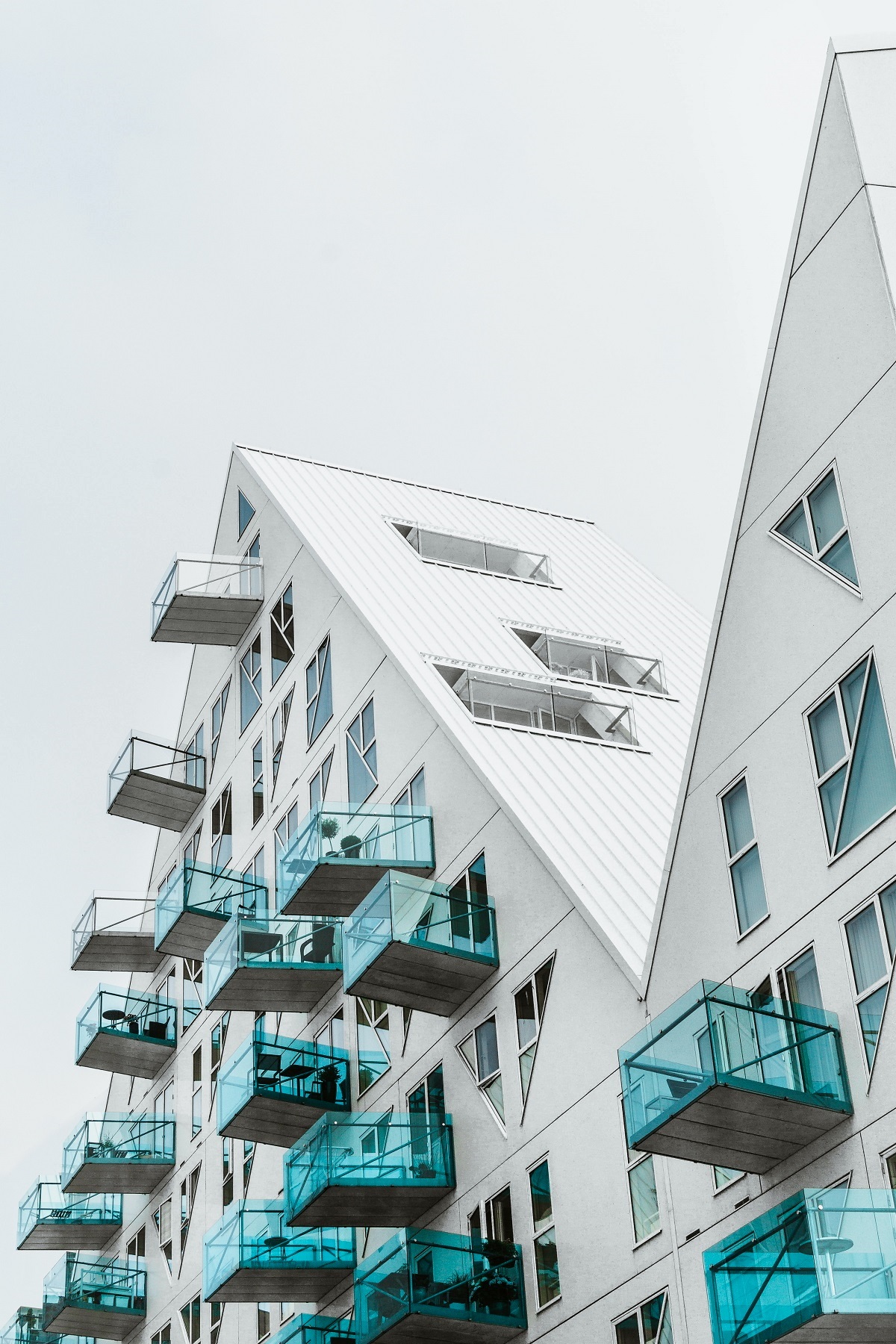
Havneholmen is a new and modern district known for eye-catching buildings in modern architecture. With the location along the harbor front and out into the water, there is a lovely setting for enjoying a stroll in the area between exciting constructions.
Havneholmen is a harbor front project that gave central Aarhus significant growth as a new district with 12,000 inhabitants and 10,000 jobs. It is thus an active district, where there are lots of homes, shops, institutions and so on.
When you take a walk in the area, there are several architectural highlights, with the Isbjerget residential area being one of the best known. It is a building that is broken by many surfaces, so that it resembles floating icebergs. The visual impression of icebergs is strengthened with the design’s visual displacement of the tops of the roofs, and it is not without reason that the Iceberg is one of Aarhus’ modern landmarks.
Underneath the current city center in Aarhus lie remains from the Viking Age settlement. During excavations for the modern bank building on Sankt Clemens Torv, for example, remains of the city’s old Viking ramparts were found, and they can now be experienced at the Viking Museum, which is set up at the site.
The museum was established in 1968 on the basis of archaeologists from Moesgård Museum, who a few years before had carried out the excavations and found these parts of Aarhus’ early history.
At the museum you can get to know parts of Aarhus from the 9th century onwards. In addition to the old ramparts, remains of houses, fences and streets were uncovered, and some fine finds of tools and pottery were also found on the site, which lies a few meters below today’s street level.
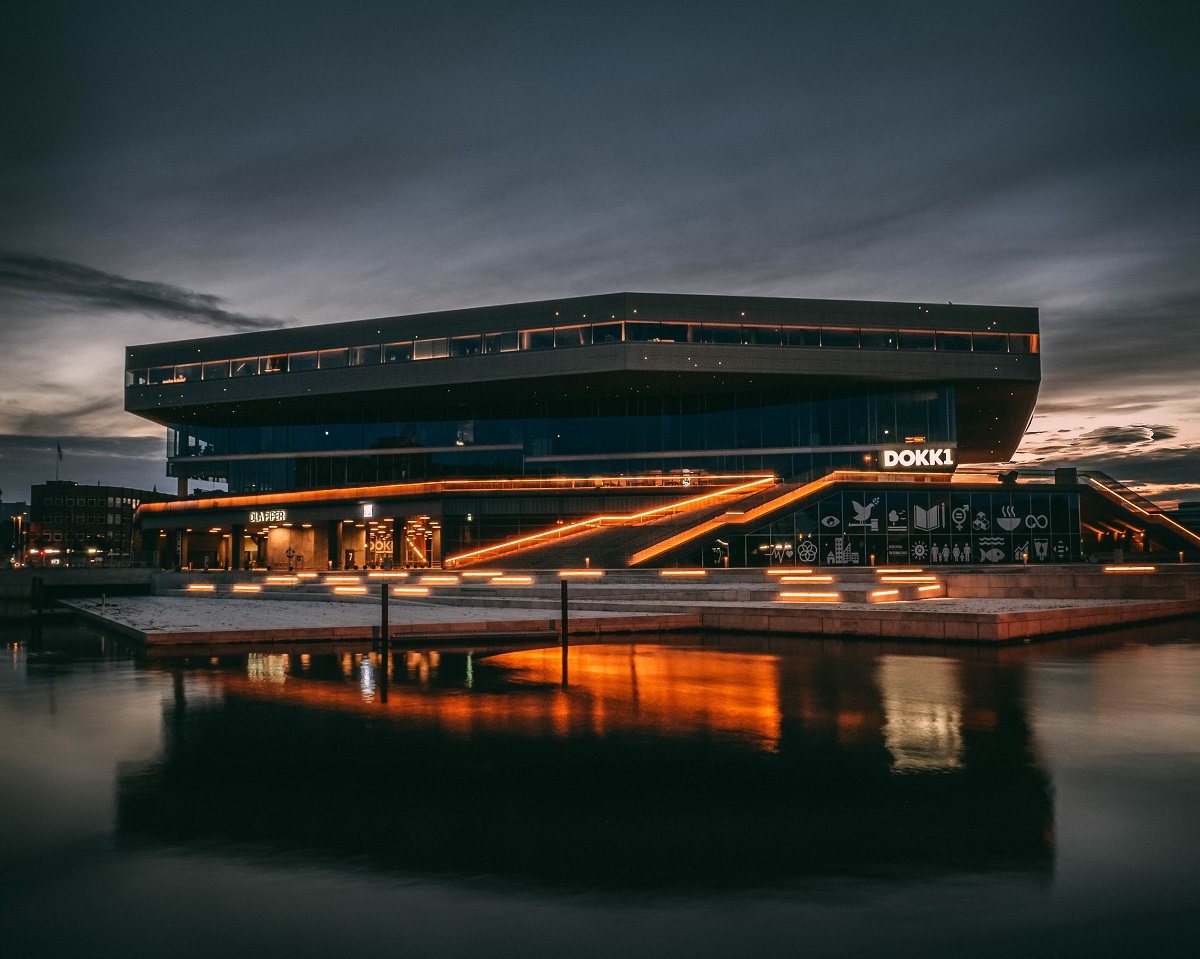
Dokk1 is the name of the Aarhus cultural flagship at Aarhus Harbour. Dokk1 contains various institutions, not least of which are the Aarhus Main Library, Aarhus Municipality’s citizen service and halls with space for e.g. theater and concerts.
Dokk1 is part of the Urban Mediaspace project, which transforms the former industrial areas around Aarhus Harbor into new assets for the city. The building opened on 20 June 2015, when Aarhus Main Library opened its doors as one of Scandinavia’s largest libraries.
The two streets Ryesgade and Søndergade together with Sankt Clemens Torv form the central pedestrian street in Aarhus. The street also goes by the name Strøget and, with around 850, is one of Jutland’s longest shopping streets.
The streets lead from the newer area around the main station to the old Aarhus by the cathedral, and a trip down Strøget therefore offers both a good opportunity for shopping and a look at some of Aarhus’ sights.
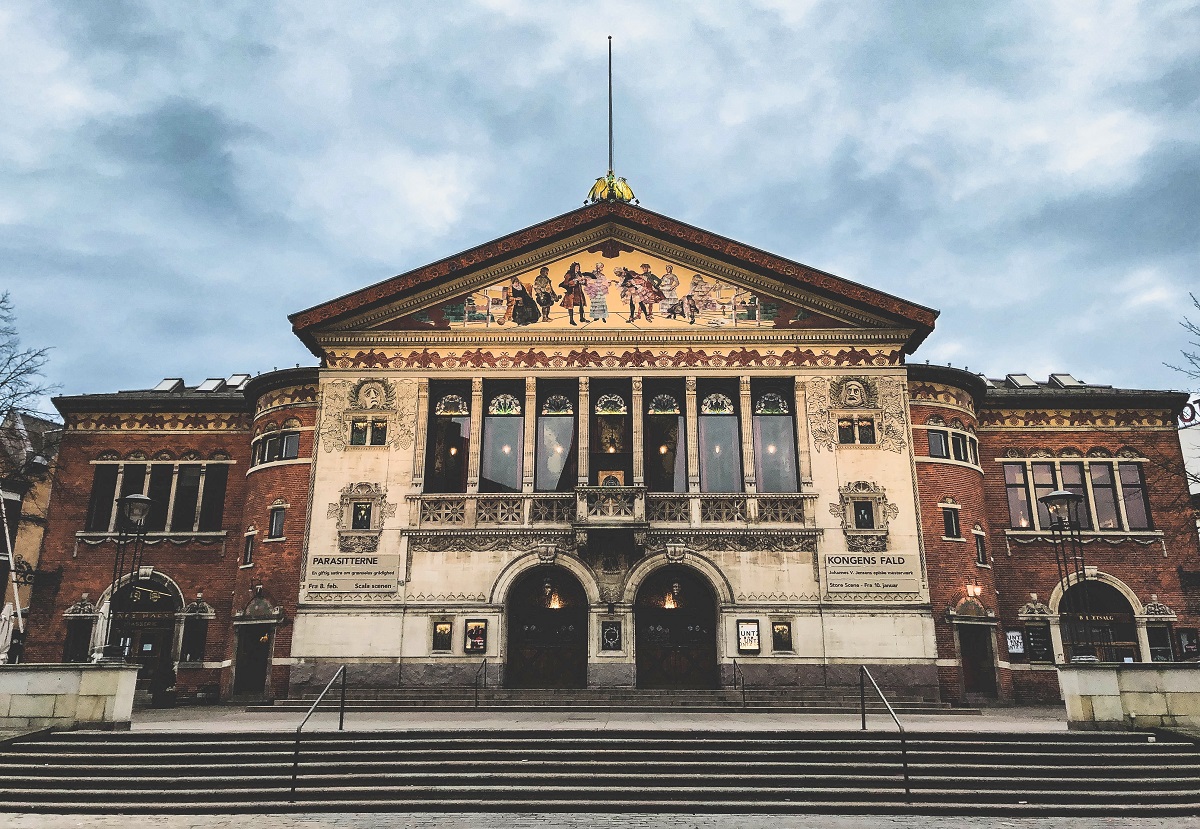
Aarhus Theater is an architectural gem in Art Nouveau style. The theater was built on the initiative of a culture-interested circle of citizens who wanted a large and significant stage as a spearhead in Aarhus. The theater was built from the end of the 19th century and it was inaugurated on 15 September 1900.
The theater was designed by Hack Kampmann, who built many of the period’s finest buildings in Aarhus. The frieze on the facade shows characters from Holberg’s works, and these were prepared by Hans Tegner. Other decoration is by the sculptor Karl Hansen Reistrup.
Aarhus Theater plays a versatile repertoire of both new and classical, and the emphasis is on Danish drama and a number of in-house productions. The theater contains five stages, of which the large stage has approximately 700 seats.
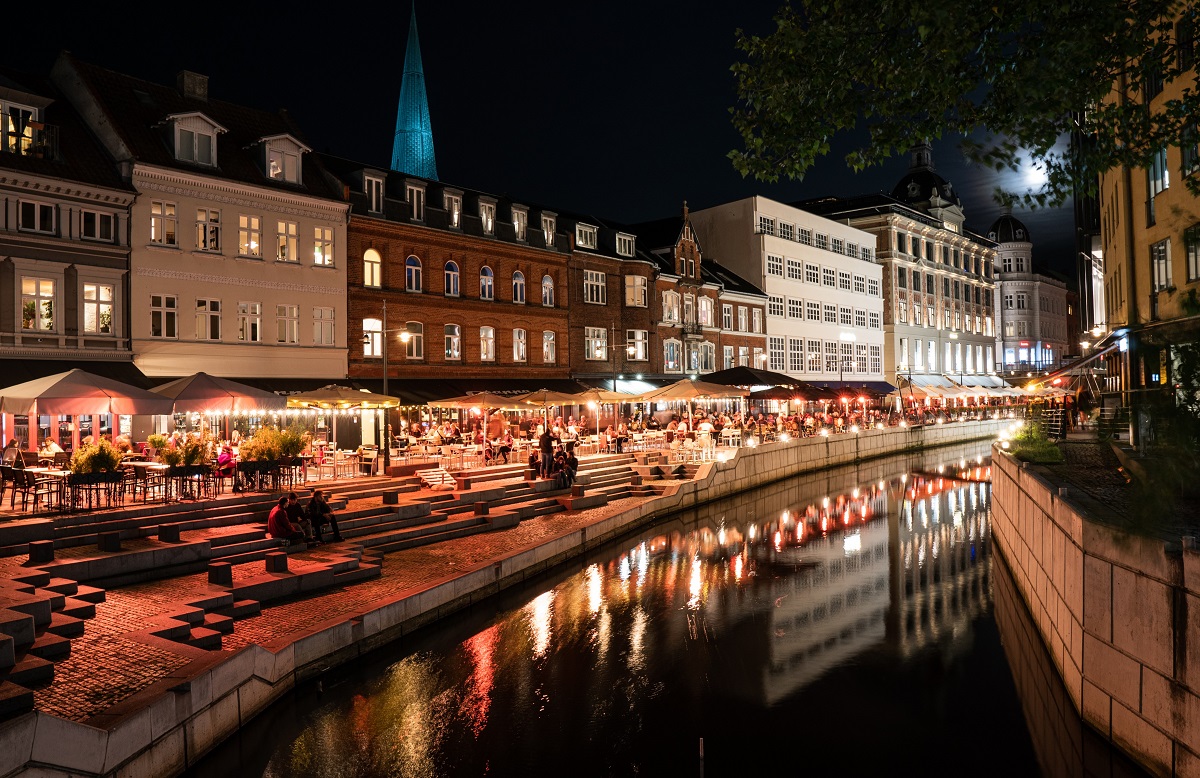
Aarhus Å is a stream with a length of 40 kilometers. It empties into the Aarhus bay and, on its last course towards the bay, has formed the historical basis for the ford, which became first a settlement and later the Aarhus you can visit today.
On the stretch around Sankt Clemens Bro, Aarhus Å was already used as a river harbor in the Viking Age. Over time, however, the ships became larger, and the harbor became too small and was therefore moved to the shore at Aarhus Bay.
In the 1930s, due to increasing traffic in the city centre, the stream was covered with the new street Åboulevarden. Based on a desire for a more car-free and green city centre, the river was opened again from the end of the 20th century, when first the section between Europaplads and Immervad was opened and later the extension to Mølleparken. During the season, the banks of the river now exude atmosphere with, among other things, outdoor serving places along the water.
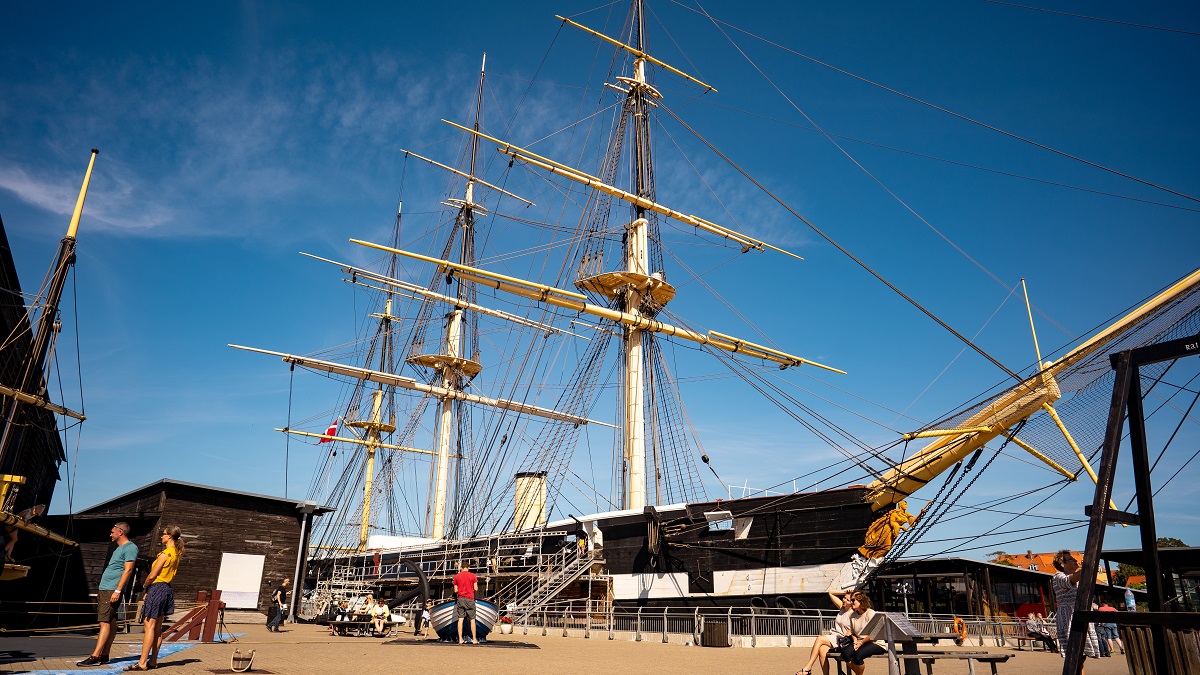
The town of Ebeltoft on Mols is known for its beautiful location and cozy town centre, which is one of the region’s most beautiful towns. The most well-known building is the town’s old town hall (Juulsbakke 1), which was built in 1789. The elegant building was designed by the architect Anders Kruuse and today houses a section of Museum Østjylland.
In Ebeltoft you can also visit the Glass Museum (Strandvejen 8), which is a museum of modern glass art by Danish and international artists. The museum is housed in Ebeltoft’s former customs booth, which was built in 1921.
The town of Ebeltoft is not least a well-visited place because of the Frigatten Jylland (S.A. Jensens Vej 4), which is a well-preserved battleship from the Battle of Helgoland in 1864. The ship was launched in 1860 from the Orlogsværftet and in its time managed, among other things, to make several voyages to Denmark West Indies.
In the 1870s, the frigate Jylland was made a royal ship, and it brought, for example, the Danish royal couple to St. Petersburg in 1876. In 1908, it was retired from the Danish fleet, where it was sold for scrapping, but fortunately saved, and since 1960 it has been in Ebeltoft , where it has been restored and is a unique maritime 19th century experience.
South of Aarhus is the Moesgård estate, whose main building was built in a classicist style from 1780 to 1784. The earlier buildings were a little further south than the current ones, and it was a three-winged structure.
Since 1964, Moesgård has been set up as a prehistoric museum depicting the ancient times of Denmark and Jutland. Outdoors, there is the baroque garden, the monument park and a number of older burial mounds.
There are particularly exciting finds to experience at Moesgård Museum, not least of which is the well-known Grauballeman. Grauballemanden is the best-preserved bog in the world; he was found in a bog at Grauballe in 1952 and is believed to date from the Iron Age around the 200s-300s.

Kalø Slotsruin is an evocatively situated ruin of the historic Kalø Castle, which was a castle complex built by King Erik Menved in 1313. It was one of several structures which were supposed to strengthen the rule of the royal power after several peasant riots. The castles were hated by the local population, and already in 1320 King Christoffer II had to order the demolition of them, including Kalø Castle.
However, Borgen Kalø Castle was quickly rebuilt, and over the centuries it was controlled by various sheriffs. The castle was for a time used as a prison, and among the prominent prisoners was the Swedish Gustav Vasa, who sat here as King Christian II’s prisoner in the years 1518-1519.
The introduction of the monopoly in 1660 was the start of Kalø Castle’s final decline. Sheriffs were no longer supposed to reside here, and as a defense structure the facility had lost its importance. A few walls remained, and these are the ones you can see today. A large part of the building materials from the demolition was sailed to Copenhagen and used for the construction of the castle Charlottenborg.
The nature around Kalø Castle Ruins is very inviting and invites you to lovely walks. From Kalø Castle you can see the walls of the castle tower and the castle ramparts.
Mols Bjerge National Park is a scenic area that was designated as a national park in 2009. Mols Bjerge is a coastal hilly landscape that offers a number of beautiful hiking opportunities and nature experiences.
From the area’s highest point, which is Agri Bavnehøj at 137 meters, there is a magnificent view over the entire mountain landscape, and from the park there are also nice views over the Aarhus Bay.
Himmelbjerget is a 147 meter high point that lies beautifully above Lake Julsø, which is the largest of the Silkeborg lakes, located between the towns of Silkeborg and Ry in one of Jutland’s most scenic forest areas.
Until the middle of the 19th century, Himmelbjerget was considered the highest point in Denmark, and even though it was not, excursions to the place became very popular; among other things with tour boats from either Silkeborg or Ry.
At the top of Himmelbjerget is a 25 meter high tower that was built in 1874-1875 in memory of King Frederik VII and the Danish constitution from 1849. This can be seen from the frieze on the four sides of the tower.
Himmelbjerget is probably the most well-known place around the Silkeborg Lakes, but there are many other opportunities for beautiful trips in the lake landscape that lies along the course of the Gudenå.
MP Bruuns Gade 25
bruunsgalleri.dk
Immervad 2-8
magasin.dk
Søndergade 27
salling.dk
Ryesgade, Søndergade, Frederiksgade, Fiskergade, Åboulevarden, Sct. Clemens Gade, Vestergade
Djurs Sommerland
Randersvej 17, Nimtofte, 45 km NE
djurssommerland.dk
Givskud Zoo
Løveparkvej 3, Givskud, 80 km SW
givskudzoo.dk
Lalandia
Billund, 100 km SW
lalandia.dk
Legoland
Nordmarksvej 9, Billund, 100 km SW
legoland.dk
Naturhistorisk Museum
Wilhelm Meyers Allé 210
naturhistoriskmuseum.dk
Steno Museum
C.F. Møllers Allé 1100
stenomuseet.dk
Tivoli Friheden
Skovbrynet
friheden.dk
The history of Aarhus dates back to the Viking Age and was first mentioned in 948 by Adam of Bremen. Remains of a marketplace from the 8th century, houses and workshops from the 9th century as well as rune stones from around the year 1000 were found. However, there was an actual settlement already in the 7th century, but this one was at Åby at the eastern end of lake Brabrand Sø.
The city was surrounded by urban ramparts and a moat that surrounded the small settlement at the mouth of Aarhus Å in the Bay of Aarhus. Aarhus Å played a significant role for its location as the inner harbor for the city.
Just Aarhus Å was also the important trade route for the first settlement at Brabrand Lake, and the city’s first name, Aros, referred to the new location with the meaning estuary.
Around the year 1200, the current Aarhus Cathedral was started just outside the city’s very old area. The church was founded by Bishop Absalon’s friend Peder Vognsen, who was a bishop in the diocese.
The cathedral building was the starting point for Aarhus’ first major expansion, and right up to the Reformation in 1536, Aarhus Cathedral played a central role in the daily life of the city. Despite various setbacks for the city over the following centuries, not least the monastic monks propelled the city forward.
From the middle of the 13th century several large plants were established in the city. Store Torv and Lille Torv were new central places created during this time, and at Lille Torv a hospital was established.
Around the year 1300 the city flourished, which led to a larger expansion. Here, among other things, the city’s first and thereby oldest town hall was built at the cathedral. Aarhus’ growth in buildings, population and trade continued in the 1400s, and in 1441 the city gained market town rights. That same year, the city received Christoffer from Bavaria as a prominent guest in Aarhus.
In 1477, King Christian I of Aarhus allowed the city to build on the surrounding defense works to ensure the city’s continued expansion. This could be done because the areas had lost their military significance, and thus new streets such as Graven and Volden could be laid out. In the 15th century, the Aarhus Latin Quarter was also established.
After the Reformation in 1536, Aarhus’ larger merchant farms became important factors of power in the city’s government and for its development, which was driven by trade for a long time.
The mid-1500s also became the starting point for a long-term recovery in Aarhus. It lasted until the mid-17th century, which became a period of much foreign penetration into the city. In 1627-1629 the city was attacked by imperial troops, and in 1644 and again in 1657-1659 the Swedes ravaged the region. In addition to the attack, Aarhus was also subject to fire tax.
Despite the assaults and a plague epidemic, Aarhus’s trade developed throughout the 17th century. The primary markets were in addition to Denmark and Norway: Lübeck, Amsterdam, England, France and Spain. The merchant fleet consisted of about 100 ships and the city was at its commercial peak.
In the first half of the 1700s, there was a decline in trade, and economically it went back to Aarhus as in many other Danish cities. The merchant fleet was halved and many of the former trading markets lapsed. By 1769 the population had dropped to about 3,500.
In the early industrialization of Aarhus, small industry and workshops started in the old grocery stores in the Mejlgade neighborhood, already built in the earliest era of Aarhus.
In the 19th century, Aarhus grew, and by 1850 the city had overtaken Randers and Aalborg as Jutland’s largest. It had in a very short time become a big city in Denmark.
The town center extended to the current railway station district, and many imposing town houses and institutions were erected, for example along Søndergade, which over time developed into part of the city’s main street.
In 1847 a major development of the port areas on the Gulf of Aarhus began. The work was completed in 1861, and together with Jutland’s first railway, which opened in 1862 between Aarhus and Randers, helped to strengthen Aarhus as the region’s leading city and the second largest city in the Danish Empire.
Aarhus’s cultural development followed the economic boom, and institutions such as Aarhus Theater were established on the initiative of a group of theater-interested residents. The construction was pompous in relation to the size of the city, which helped to emphasize the city’s leading role.
Throughout the first half of the 1900s, Aarhus continued to develop, and a significant part was the establishment of the University of Aarhus, which with its large academic and geographical area made the city the leader in the country after Copenhagen in the field of education.
Aarhus is still characterized by the active student and research community that developed together with the founding of educational institutions. Today, Aarhus has about 300,000 inhabitants, and it is characterized by a very active business community as the center of Jutland.
The cultural boom that started in the 19th century continued through the 20th century to the present day. The Old Town shopping mall is a unique museum, and with the Music House, the modern art museum, ARoS and the Aarhus Main Library in the newly developed harbor area, the city is well underway. Investments are also being made in Aarhus in other ways, and one of them is the city’s infrastructure with the city’s new and modern light rail, which was inaugurated in 2017.
 Aarhus, Denmark[/caption]
Aarhus, Denmark[/caption]
Overview of Aarhus
Aarhus is a cozy city with lovely pedestrian streets such as the stretch between the city’s main railroad station and Aarhus Cathedral. The attractions in the same city center area are interesting to see, and there is also access to the beautiful and relatively new city scape along the river Aarhus Å.
Aarhus’s churches are also some interesting places to visit. The city’s cathedral is one of the country’s largest churches, and the neighboring Our Lady exudes medieval character. The contrast from here to the new buildings in the port area of Aarhus is great and perspective-rich as each a contemporary architectural gem.
Aarhus also has a few must visit museums, where some of the well-known ones are the ARoS art museum and the fantastic market town environment from a bygone era in The Old City. The Old City is a unique market town museum with a collection of older houses that have been moved to here, and in addition you can visit places that stand as time capsules, for example, from several periods in the 1900s.
About the Whitehorse travel guide
Contents: Tours in the city + tours in the surrounding area
Published: Released soon
Author: Stig Albeck
Publisher: Vamados.com
Language: English
About the travel guide
The Whitehorse travel guide gives you an overview of the sights and activities of the Canadian city. Read about top sights and other sights, and get a tour guide with tour suggestions and detailed descriptions of all the city’s most important churches, monuments, mansions, museums, etc.
Whitehorse is waiting for you, and at vamados.com you can also find cheap flights and great deals on hotels for your trip. You just select your travel dates and then you get flight and accommodation suggestions in and around the city.
Read more about Whitehorse and Canada
Canada Travel Guide: https://vamados.com/canada
City tourism: https://visitwhite-horse.ca
Main Page: https://www.vamados.com/
Buy the travel guide
Click the “Add to Cart” button to purchase the travel guide. After that you will come to the payment, where you enter the purchase and payment information. Upon payment of the travel guide, you will immediately receive a receipt with a link to download your purchase. You can download the travel guide immediately or use the download link in the email later.
Use the travel guide
When you buy the travel guide to Whitehorse you get the book online so you can have it on your phone, tablet or computer – and of course you can choose to print it. Use the maps and tour suggestions and you will have a good and content-rich journey.


Havneholmen is a new and modern district known for eye-catching buildings in modern architecture. With the location along the harbor front and out into the water, there is a lovely setting for enjoying a stroll in the area between exciting constructions.
Havneholmen is a harbor front project that gave central Aarhus significant growth as a new district with 12,000 inhabitants and 10,000 jobs. It is thus an active district, where there are lots of homes, shops, institutions and so on.
When you take a walk in the area, there are several architectural highlights, with the Isbjerget residential area being one of the best known. It is a building that is broken by many surfaces, so that it resembles floating icebergs. The visual impression of icebergs is strengthened with the design’s visual displacement of the tops of the roofs, and it is not without reason that the Iceberg is one of Aarhus’ modern landmarks.
Underneath the current city center in Aarhus lie remains from the Viking Age settlement. During excavations for the modern bank building on Sankt Clemens Torv, for example, remains of the city’s old Viking ramparts were found, and they can now be experienced at the Viking Museum, which is set up at the site.
The museum was established in 1968 on the basis of archaeologists from Moesgård Museum, who a few years before had carried out the excavations and found these parts of Aarhus’ early history.
At the museum you can get to know parts of Aarhus from the 9th century onwards. In addition to the old ramparts, remains of houses, fences and streets were uncovered, and some fine finds of tools and pottery were also found on the site, which lies a few meters below today’s street level.

Dokk1 is the name of the Aarhus cultural flagship at Aarhus Harbour. Dokk1 contains various institutions, not least of which are the Aarhus Main Library, Aarhus Municipality’s citizen service and halls with space for e.g. theater and concerts.
Dokk1 is part of the Urban Mediaspace project, which transforms the former industrial areas around Aarhus Harbor into new assets for the city. The building opened on 20 June 2015, when Aarhus Main Library opened its doors as one of Scandinavia’s largest libraries.
The two streets Ryesgade and Søndergade together with Sankt Clemens Torv form the central pedestrian street in Aarhus. The street also goes by the name Strøget and, with around 850, is one of Jutland’s longest shopping streets.
The streets lead from the newer area around the main station to the old Aarhus by the cathedral, and a trip down Strøget therefore offers both a good opportunity for shopping and a look at some of Aarhus’ sights.

Aarhus Theater is an architectural gem in Art Nouveau style. The theater was built on the initiative of a culture-interested circle of citizens who wanted a large and significant stage as a spearhead in Aarhus. The theater was built from the end of the 19th century and it was inaugurated on 15 September 1900.
The theater was designed by Hack Kampmann, who built many of the period’s finest buildings in Aarhus. The frieze on the facade shows characters from Holberg’s works, and these were prepared by Hans Tegner. Other decoration is by the sculptor Karl Hansen Reistrup.
Aarhus Theater plays a versatile repertoire of both new and classical, and the emphasis is on Danish drama and a number of in-house productions. The theater contains five stages, of which the large stage has approximately 700 seats.

Aarhus Å is a stream with a length of 40 kilometers. It empties into the Aarhus bay and, on its last course towards the bay, has formed the historical basis for the ford, which became first a settlement and later the Aarhus you can visit today.
On the stretch around Sankt Clemens Bro, Aarhus Å was already used as a river harbor in the Viking Age. Over time, however, the ships became larger, and the harbor became too small and was therefore moved to the shore at Aarhus Bay.
In the 1930s, due to increasing traffic in the city centre, the stream was covered with the new street Åboulevarden. Based on a desire for a more car-free and green city centre, the river was opened again from the end of the 20th century, when first the section between Europaplads and Immervad was opened and later the extension to Mølleparken. During the season, the banks of the river now exude atmosphere with, among other things, outdoor serving places along the water.
Similar to Aarhus Travel Guide
